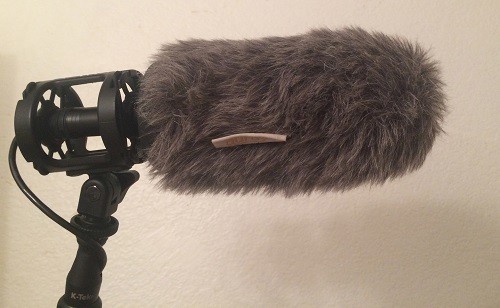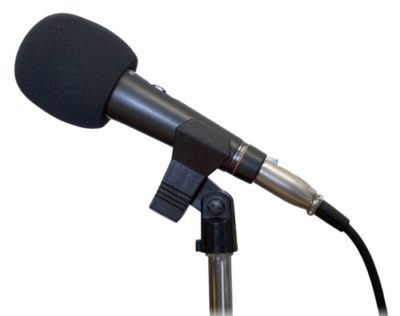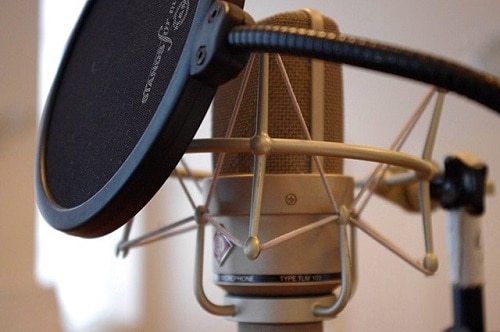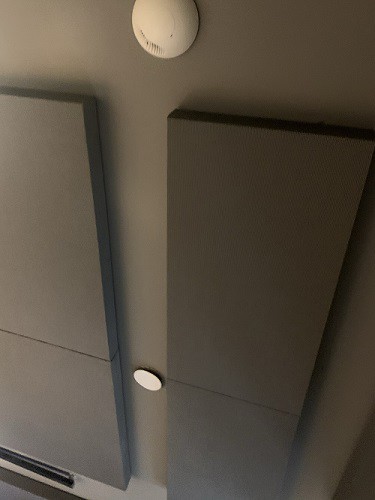How To Get Rid Of Background Noise On Mic
Whether you're on stage or in the studio, whether you're micing a singer, acoustic guitar, guitar amp, or drums, one question which every audio engineer should ask himself will always be of crucial importance for good sound is: "how to reduce the background noise on a mic to get the best sound?" Not every microphone is the same, not every room is the same, not every performer is the same. That's why we will give you several tips on how to get rid, or at least, reduce microphone background noise in live performance or when recording music, whether you use dynamic mics or condenser mics.
To get rid of background noise on a microphone: you need to eliminate ambient noise sources. Move noisy equipment further away from the mic. Close windows and doors to reduce road noise. Move your microphone away from computer fan and use a pop shield to block breathing sounds when you are speaking.
It's not always possible to remove ambient noise entirely, but there are still a number of things you can do to minimize it. But first, let's learn something about mic audio noise.
Types of Unwanted Sounds
Mic noise can be defined as "unwanted sound". Basically, the duration and level of the background sounds determine the characteristics of noise. If you want to know how to make your mic sound better, it's important to know the 3 main noise types.
- Broadband Noise (or continuous noise) is the noise in which the acoustic energy is distributed over a wide range of frequencies as it is picked up by a microphone. The sounds like hiss and static noise belong in this category.
- Narrow Band Noise is limited to a narrow range of frequencies. This kind of noise has a constant audio level usually caused by incorrect grounding and poorly shielded cables connecting microphones. Narrow Band Noise is basically any unwanted signal that remains steady over time.
- Impulse Noise includes sharp sounds such as clicks and pops in a mic. It has a high frequency and short duration.
* Irregular background noises include unwanted sounds such as rain, traffic, background conversation, speech etc. These kinds of sounds are very difficult to remove because they are produced from many random sounds that differ in frequency and sound volume.
* Electrical noise (60/50 Hz hum), or buzzing sound could also be a big problem. Make sure all your recording equipment is connected to the same power strip. Also, you should keep microphone cables away from electricity cables.
*The noise floor is the level of background noises in a signal or the level of noise introduced by the sound system.
Start reducing noise from the very first sound source – your microphone. Here are 9 ways it can be done –
1) Microphone Sensitivity And Gain Setup
Microphone sensitivity is very important when choosing the right mic for your needs. Usually, it's measured with a 1 kHz sine wave at a 94 dB sound pressure level (SPL).
You should know that some microphones are more sensitive than others and the audio quality of it is not really related to its sensitivity. Once exposed to the same sound source, various microphone models might generate totally different audio output levels. A measure between the microphone's noise level, clipping point, distortion, and sens defines whether or not a microphone may be a good fit for a specific use. A microphone with high sensitivity might require less preamp gain. Also, it may have less headroom before clipping than a mic with lower sensitivity. It's also worth keeping in mind that your end result will depend a lot on microphone quality. If you start with a poor mic, no amount of filters or processing is going to make it any better or help you reduce background noises and get rid of static.
Dynamic microphones generally have a very low sensitivity while condenser microphones usually have a higher sensitivity. The microphone signal level may be easily adjusted to the desired input level with the proper preamp gain. Be aware that each gain stage will include some noise into the signal. It's up to you or your audio engineer to make sure that every gain level is good enough to keep its input noise from corrupting the audio signal. Proper microphone gain setup should keep noise out of your output. Set the correct input level of your sound source and use balanced audio connections, to prevent the reasons why a mic would pick up everything in the background.
If your mixing desk or audio interface has a microphone boost option, try turning that off, or all the way down to keep noise at a minimum.
Keep environmental background noises out of your live performance or audio recording with advanced equipment.
2) Microphone Windshield (Windscreen) to Suppress Outdoor Sounds
Foam or fur (Windjammer); actually the combination of these two products are great for blocking the noises produced by the wind. It should be placed over the microphone's head. This "dead cat" designed accessories will prevent wind interference as well as heavy breathing and pop noises. These windshields offer up to 12dB wind noise rejection. All the windscreens would slightly reduce the total level of the microphone volume and selectively lower the level of higher frequencies. However they achieve this with less audio interference from the ambient air and reduce background noise, any microphone you use with windshield will deliver cleaner sound. Use it. Also you may want to check out the Rode Rycote Shotgun Mic on Amazon for outdoor work.
on Amazon for outdoor work.
#ad

3) Pop Filter to Eliminate Unwanted Sounds
What does a pop filter do? If you want to avoid plosive and sibilance from your recording you should consider using pop filters for your microphones. It is generally not for outdoor use and you can see it usually used in studio / home studio. It is a filter which is placed between a singer / speaker and the microphone. A pop filter comes in a round disc looking object which should be mounted on a mic stand and has a flexible boom to place it exactly where needed. Looks like a big lollipop. This lollipop eliminates or reduces plosives so the microphone will not pick up an explosion of sound(pop noise) and will help against picking up noises from the background too. Also, it helps keep moisture off the mic, which is good for your equipment. Some microphones, such as the SM58, have a built in pop filter under the metal casing, that does reduce this problem a little bit. A pop filter can also help to some extent with sibilance on vocals. To get the price of a pop filter I recommend on Amazon, click here 
#ad
Check out my other post – Do dynamic microphones need pop filters?
*Some microphones actually have a pop filter built-in, so you should do your research.

4) Stop Picking Up Background Sounds with a Microphone Shock Mount
Every modern microphone is very sensitive and prone to picking up background noise. Shock mounts are a great way to protect a microphone from shocks and vibration, and if you want to get the best possible performance and sound quality. A shock mount will effectively reduce microphone handling noise. Use shock mounts on mic stands to reduce background noise caused by tremors and vibrations from the mic stand itself and from people walking across the floor. Check out this great microphone and shock mount for studio work .
.
#ad
Now, when you have a good sound with minimal background noises from the very beginning, you can go to the next level of even more mic noise reduction. Sound processing.
To check the price of shock mounts on Amazon, click here 
#ad

5) Filters for Mic Static Noise, Hiss, Hum and Other Sounds
Filters will not change or add new frequencies to the audio input signal. Filters are often used to highlight the signals in certain frequency range and reject signals in other frequency bands such as those associate with background noises and unwanted microphone sounds.
You should apply a high pass / low cut background noise filter which removes low-frequency rumble and DC offset. Set the frequency control at 10 Hz if you want to eliminate DC offset only. A harmonic notch filter cut at 50 Hz or 60 Hz will be able to ensure that AC hum is easily removed.
These are five basic filter types:
- Bandpass filter is used in audio systems to separate a signal at one frequency or within a band of frequencies from signals at other frequencies.
- Notch or Band-Reject is a filter with the opposite function of the bandpass. This filter is used to reduce background noise by removing an unwanted frequency from a signal while affecting all other frequencies as little as possible.
- Low-Pass filter permits low-frequencies and rejects audio signals above the filter's cut-off frequency. Low-pass filters are used whenever high frequencies should be removed from a signal.
- High-Pass is the opposite of the low-pass filter, which rejects signals below its cut-off frequency. High-pass filters are used in cases when the rejection of low-frequency signals is needed.
- All-Pass (or Phase-Shift) filter type has no effect on the amplitude of the signal. Its function is, without affecting its amplitude, to change the phase of the signal.
The most popular and can be found on any mixer is a low cut (high-pass) filter which reduces low-frequency rumble from an audio or mic signal. Start from 20hz and go up until you find the sweet spot without affecting sound source. For example, for male vocals, you could go up to 100hz. For a female, up to 120hz. Experiment to get the best possible microphone noise reduction. If you want to removed static, these filters can be quite effective.You should also
After we have applied the filters, if background sounds are still present, we should fine-tune the signal with the equalizer.
6) Equalization to Remove Unwanted Audio and White Noise
What is the equalizer? Equalizer (EQ) is a software or hardware filter that adjusts the frequency of certain frequencies.
What is equalization? Equalization is optimizing frequencies of sound. Through the equalization process, we can increase or decrease the volume of the selected frequency, such as those that are coming from background noises from a mic.
Every sound has its frequency and certain frequencies are louder than others. Because of that, we use an equalizer to "equalize" these frequencies. This means that we will reduce frequencies that are dominant or increase those that are missing in order to achieve the best sound. Using Equalizer is quite easy, especially if it has its own analyzer. With the help of analyzer, you can easily see which frequency is messing your performance and reduce it.
If we're talking about an audio recording and for example, if that recording of your voice has the so-called white noise (hiss) and your analyzer shows the dominant frequency of 7khz, simply select and reduce that frequency with your equalizer. You should be able to fix the microphone white noise and notice the difference instantly.
On the other hand, if we are talking about live performance, and you do not have a digital mix, you have to rely on your ears. Each tone has its own frequency. Microphones placed wrongly on a stage will cause feedback issue and you may also have certain sounds that are more noticable because of acoustic echo and background noise, but you can also use eq to try and resolve this too with a process called acoustic echo cancellation. Acoustic echo cancellation can be achievable with using some skill with equalization. Practice identifying which frequency is accentuated or missing.
*Every audio engineer will tell you that the first thing you should try with EQ is to reduce the level of frequency, not increase it.
In any case, the noise gate is a very useful audio processing application. So, if you have the option to use it for live performance (digital mixer, or an external unit), it will significantly help you to reduce background noise. It can also be of great importance in post production.
Table of common background noises
| PC silent fan | 20-25 dB |
|---|---|
| PC performance fan | 30-35 dB |
| Barking dog | 85-120 dB |
| Snoring dog | 50-65 dB |
| Road traffic | 70-80 dB |
| Road traffic (windows closed) | 35-45 dB |
| Air conditioner | 60-65 dB |
| Telephone ringing | 70-80 dB |
| Computer keyboard | 50-60 dB |
| Computer mouse click | 50-75 dB |
7) How to Cancel Unwanted Sounds with a Noise Gate
A noise gate is usually used for the reduction of unwanted external sounds and to help reduce background noise. It allows an audio signal to pass through only when it is above a threshold value. In other words, it is usually used when the level of the audio signal is above the level of the noise. If properly set, the noise gate will reduce steady noise static from amplifier and hum from the power supply system and power cable without affecting the sound source. With very few adjustments, with the help of the gate, you can get rid of the unwanted background noise or static audio that your microphone picks up, either at the stage or in your home studio. If you are still getting mains hum causing audio interference, you could try changing over to another power socket.
Noise gate software or hardware usually has 5 parameters:
- Threshold sets the level at which the gate opens to let the sound go through.
- Ratio is the balance between the original sound and the gated sound.
- Attack sets the time it takes for the gate goes from a closed to an open state.
- Hold permits the gate to be kept in an open state after the signal level has fallen below the threshold.
- Release is usually used to set how long it takes for the gate to go from fully open to fully closed. A fast release quickly cuts off the sound. Slower release is acting like a fade out.
*If you set the release to fast it could induce a clicking sound.
8) Noise Reduction Software and Audio Recording
If you can't find a better solution and you need the noise reduction software, be sure that the noise removal process must be carefully used as it can lead to a loss of audio data. Sometimes it is better to leave some noise in the recording than to remove a significant part of your audio material.
Audio noise suppression software helps remove background noise from an audio signal. The goal of any noise suppression process is to take a noisy signal and isolate the clean sound signal from the noise.
There is a lot of noise cancelling software plug-ins on the market. Basically, every noise reduction plugin works according to the same principle. "Get noise print and – apply". The difference is only in additional parameter settings. Some companies even offer full-featured DAW (digital audio workstation) for sound restoration. For example, well known Izotope, with its latest rx7 audio editor software for post production, offers a range of incredible possibilities for achieving the professional sound. Worth every penny. The complete rx7 audio editor contains De-Noise, De-Click, De-Crackle, De-Hum, De-Plosive, De-Ess, De-Reverb, De-Rustle, De-Wind, Dialogue Isolate, Spectral De-Noise, Voice De-Noise, Mouth De-Click, EQ Match plug-ins and much more. Really amazing and useful stuff. Other companies that are also prominent with their audio restoration software are Adobe (Audition CC), Acon Digital (Acoustica 7, Restoration Suite), Audacity (free), Sonnox Restore, Waves, Antares (SoundSoap), Zynaptiq (Un-series), Sound Forge, Cedar Studio etc.
You can guess which one is most popular among audio hobbyists. You're right, Audacity. You may want to check out my Audacity video course here.
Audacity is actually a free audio editing software which has a quite decent Noise Reduction tool plug-in, and it's available for Windows 10, Windows 7 and Apple Mac OS and Linux operating system. There are not as many advanced options as rx7, but it can do the job if you want to capture your performance and remove background noise out of your recording.
Using excess noise removal in Audacity is pretty easy. The first thing you need to do is open the plug-in, select a region of your sound recording that contains only the so-called "room tone", or, in our case, noise, click on "get noise profile". Select all of the audio from which you want background noise removed and after that, just click ok. At the same time, you will hear the improvement in your audio track. If you still require an even better sound, than you should play with other parameters. It is also possible to do echo cancellation if required. This method can be used with recording from a PC sound card, USB interface or other sources such as a potable recorder, mixing console or video camera.
If you are recording from computer make sure your audio drivers are up to date, as an out of date driver can be a source of crackles, clicks and other sources of noise. If using Windows 10 or another OS, make sure everything is updated as thus can also cause noise problems.
To check the price of acoustic noise reduction panels on Amazon, click here 
#ad

9) Adaptive Noise Reduction and Cancellation Technology
Noise cancellation method uses a reference audio input signal which contains only noise. This signal is transmitted through an adaptive filter and later decreased from the primary input. This Noise Reduction effect can quickly reduce background noise such as fans, air conditioners, background conversations, rain, wind etc. Almost any advanced Noise Reduction software contains an adaptive noise cancellation option. Basically, it is very useful for "live" (real-time) noise removal.
Basically every audio recording contains a certain amount of noise. To produce the best audio recordings, these unwanted sounds must be removed as much as possible with ambient noise reduction. Until just a few years ago, ambient noise reduction was a very difficult and expensive process. The new generation of high-speed computers equipped with quality sound cards and microphone noise cancelling software has made audio noise removal very easy. There is also the possibility of using a real-time noise cancelling microphone. These noise cancellation filters are getting better as the technology improves. If you adhere to these tips, you will keep the mic background noise away from your live performances or studio recordings. At the very least, you will significantly reduce ambient noise in your output signal with microphone noise reduction software. In the end, that's the whole point, right?
Some products you might like –
Here are some products from Amazon that I have found helpful in reducing noise –
Picking up keyboard noise on microphone?
How to get rid of keyboard noise on a mic: there are a number of things you could try – turn down the gain, move the mic further away from the keyboard, swap your keyboard out for a quieter one.
How can I Stop noise on Blue Yeti mic?
Blue Yeti background noise fix: to solve this problem, first check the software settings and drivers are up to date, turn down gain, try changing polar pattern setting also moving the mic away from noise sources such as pc fan etc.
Solving headphone noise on mic?
How to fix microphone picking up audio from headphones: a few things to try – if using a headset mic, try an external mic that is further away from the headphones; turn done headphone volume, turn down mic gain.
Pop filter or windcat for background noise?
Pop filter vs windscreen – which is best? It really depends what you are using them for. Pop filters are better for indoors and cutting out unwanted breathing sounds. Windscreens are better for outdoors and cutting down wind noise.
Pop filter on mic stand?
How to attach a pop filter to a mic stand: it's a good idea to do this because if your mic is picking up noise form a particular direction, most pop filter attachments allow you to point it in the direction of the noise, thus helping to block it.
If you would like to share this post you can copy this link and then paste on social media or your blog –
https://churchsoundtips.com/mic-backgnd-noise/
How To Get Rid Of Background Noise On Mic
Source: https://churchsoundtips.com/mic-backgnd-noise/
Posted by: arciniegaseents.blogspot.com

0 Response to "How To Get Rid Of Background Noise On Mic"
Post a Comment